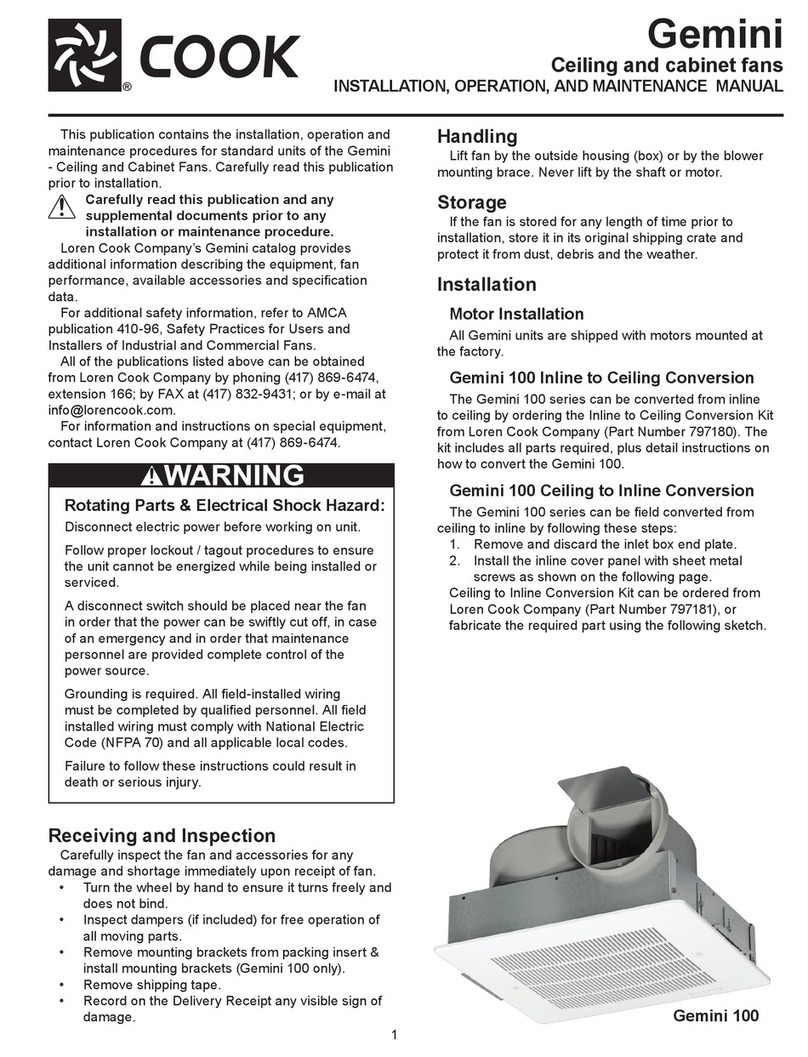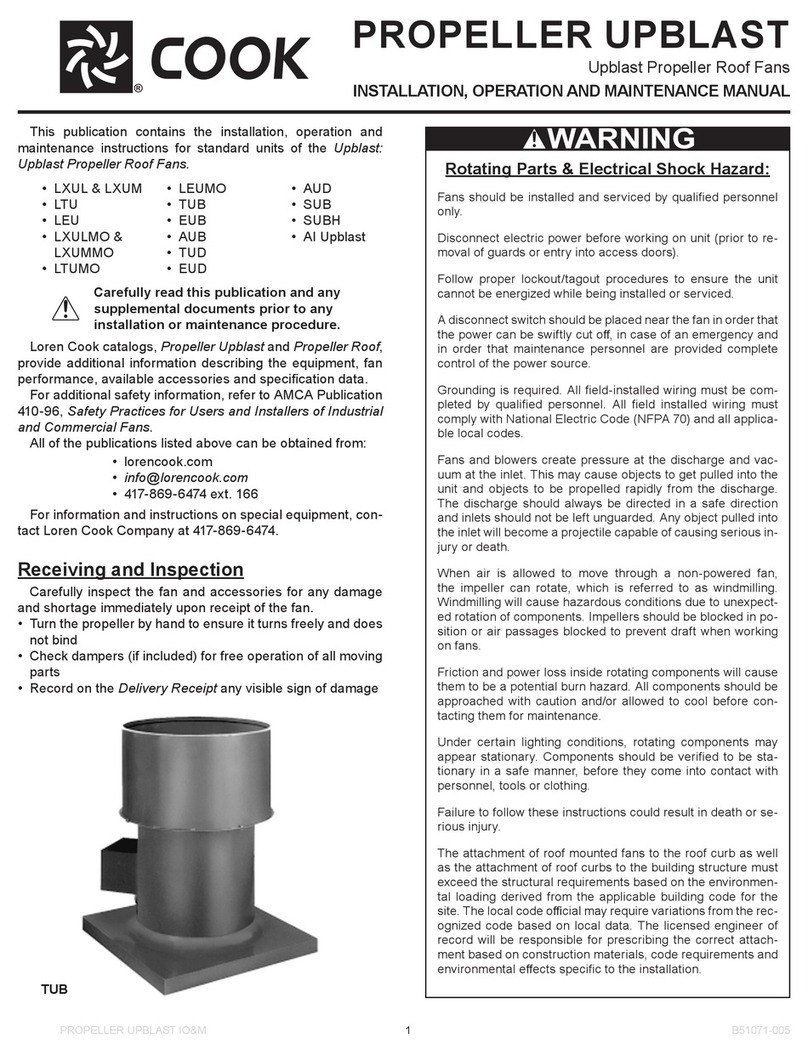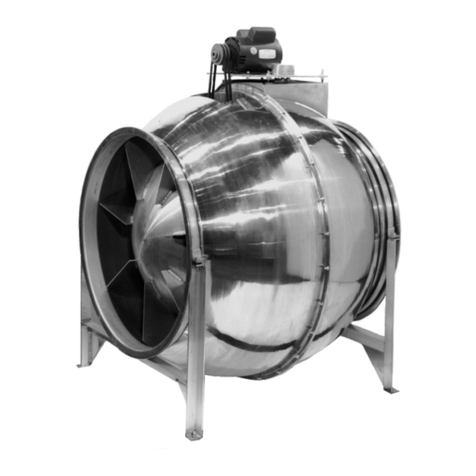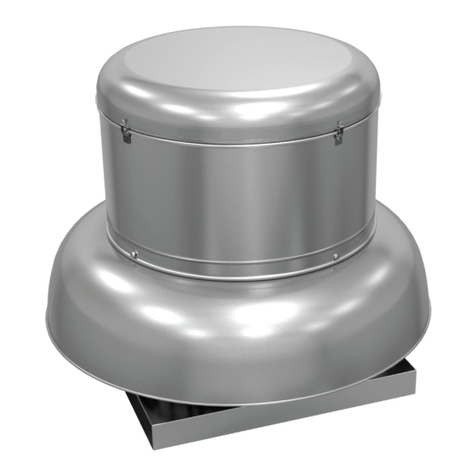
4H-SERIES IO&M B51051-003
Fan Installation
The fan support (roof curb) should provide a level sur-
face for installation. If the roof is pitched more than 1/2:12,
a sloped curb must be used to correct the problem.
Place fan over roof opening. Secure the fan with lag
screws, anchor bolts, or other suitable fasteners.
Hood Assembly
Hoods for some non-ltered fans (size 42 and larger)
and some ltered fans (size 36 or larger) require eld as-
sembly. Assembly is accomplished using 1/2” and 9/16”
socket wrenches. Line-up punches and hand clamps will
speed up the assembly. Figure 4 shows the components
used to assembly the hood.
1. Place the hood halves (A) onto the hood supports (D).
Line up the hood anges and bolt the anges of the
hood ends (G) together. The top caps (B) must be in-
ter-locked for the anges to meet correctly.
2. Go under the hood and bolt the hood (angle ange) to
the hood supports (D) at the four overlapping locations.
3. Install the two perimeter angles (C), that were shipped
loose, inside each end of the hood.
4. If there is a gap between the top cap edges, loosen
the top cap bolts. Install a bolt in each end of the top
cap ange to pull the two top caps together. Tighten
the top cap bolts.
Filtered Fans
1. Place the two long lter retainers (E) (four on size 60)
and the two short lter retainers (F) on top of the base
and bolt the pieces together.
2. Bolt the long lter retainers (E) to the perimeter angles
(C) that are at the ends of each hood.
3. Install lters according to the lter schedule. Refer to
Filter Installation detail below. Insert edge of lters into
the lter retainer (E), swing lter into position and ip
the lter holding clip into position.
H-Series Fan Filter Sizes
Unit Size Type 1 Type 2
Length x Width No. Req. Length x Width No. Req.
20 14” x 14” 414” x 18-7/8” 6
24 18-1/4” x 30-1/8” 218-1/4” x 33-1/4” 4
30 20-7/16 x 18-1/16” 420-7/16” x 25-13/16” 6
36 22-1/4” x 21-1/16” 422-1/4” x 29-5/32” 6
42 24-1/16” x 29-1/2” 426-7/8” x 19-1/4” 8
48 27” x 27” 427” x 27” 8
54 29-1/8” x 20” 629-1/8” x 23-5/8” 10
60 37-11/16” x 21-7/8” 626” x 28-5/16” 10
Final Installation Steps
1. Inspect fasteners and setscrews, particularly fan mount-
ing and bearing fasteners, and tighten according to the
recommended torque shown in the table, Recommend-
ed Torque for Setscrews/Bolts.
2. Inspect for correct volt-
age with voltmeter.
3. Ensure all accessories
are installed.
4. Test the fan to be sure
the rotation is the same
as indicated by the arrow
marked Rotation.
Do not allow the fan to run in the wrong direction.
This will overheat the motor and cause serious
dam-age. For 3-phase motors, if the fan is running
in the wrong direction, check the control switch.
It is possible to interchange two leads at this lo-
cation so that the fan is operating in the correct
direction.
Operation
Pre-Start Checks
1. Lock out all the primary and secondary power sources.
2. Inspect fasteners and setscrews, particularly those
used for mounting the fan, and tighten if necessary.
3. Inspect belt tension and pulley alignment. (Remember,
if belt tension is correct, a loud squeal occurs as the
fan increases to full power.)
4. Inspect motor wiring.
5. Ensure the belt touches only the pulleys.
6. Rotate the propeller to ensure it does not rub against
the venturi.
7. Ensure fan and duct work are clean and free of debris.
Test the fan to ensure the rotation of the propeller is
the same as indicated by the rotation label (The HER
has a reversible propeller and can be operated in ei-
ther direction).
8. Close and secure all access doors.
9. Restore power to unit.
Recommended Torque for Setscrews/Bolts (IN-LB)
Setscrews Hold Down Bolts
Size
Key Hex
Across
Flats
Recommended
Torque Size Recommended
Torque
Min. Max.
#8 5/64” 15 21 3/8”-16 324
#10 3/32” 27 33 1/2”-13 780
1/4 1/8“ 70 80 5/8”-11 1440
5/16 5/32” 140 160 3/4”-10 2400
3/8 3/16” 250 290 7/8”-9 1920
7/16 7/32” 355 405 1”-8 2700
1/2 1/4“ 560 640 1-1/8”-7 4200
5/8 5/16” 1120 1280 1-1/4”-7 6000
3/4 3/8” 1680 1920 - -
7/8 1/2” 4200 4800 - -
19/16” 5600 6400 - -
Start Up
Turn the fan on. In variable speed fans, set the fan to its
lowest speed. Inspect for the following:
• Direction of rotation
• Excessive vibration
• Unusual noise
• Bearing noise
• Improper belt alignment or tension (listen for a continuous
squealing noise)
• Improper motor amperage or voltage
NOTICE! If a problem is discovered, immediately
shut o the fan. Lock out all electrical power and
check for the cause of the trouble. Refer to Trou-
bleshooting, page 7.
Inspection
Inspection of the fan should be conducted at the rst 30
minute, 8 hour and 24 hour intervals of satisfactory op-
eration. During the inspections, stop the fan and inspect as
per the following:
Filter
Schedule
Type 2
Type 2
Type 2
Type 2
Type 2
Type 2
Type 2
Type 2
Type 2
Type 2
Type 1
Type 1
Type 1
Type 1
Type 1
Type 1






























